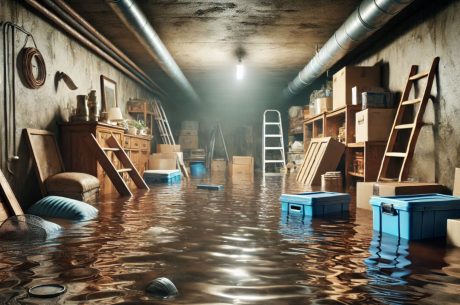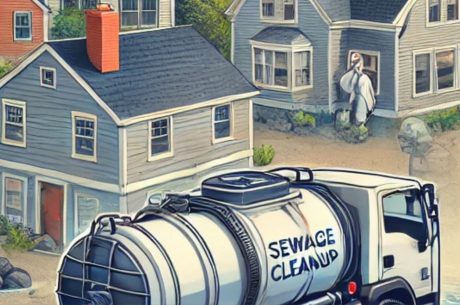How to Stop Yard Flooding in Maine
Nothing beats the sweetness in springtime air, where flowers bloom and the breeze carries the scent of new life. Unfortunately, with all this verdant rejuvenation comes something less pleasant for many homeowners: yard flooding. The oncoming spring rainfall and snowmelt can turn your beautiful lawn into a soggy mess that stubbornly refuses to drain.
Heavy rain can often lead to problems like soil erosion and water damage to your home’s foundation. Water flowing close to your property may also cause mold damage. If you’ve been wading through seemingly endless puddles in your backyard after heavy spring rains, don’t worry. This comprehensive guide will help you transform your personal oasis from flood-prone to flood-resistant.
Understanding the Problem…
Before we discuss solutions, it’s crucial to understand what causes yard flooding. For many properties, it’s a combination of inadequate drainage and the natural saturation of soil after heavy downpours. There are several factors to keep in mind:
- Clay soil is known for its poor drainage.
- Improper grading or low-lying areas can lead to standing water in the yard.
- Little or no vegetation and trees can make it difficult for standing water to drain.
- Snowmelt in colder climates poses a risk of flooding. Snow melting on the roof can pool around the foundation of your home.
- Some areas are prone to flash floods.
- Weather patterns can cause an increase in flooding from oceans or lakes. It can also affect the frequency of natural disasters or heavy rain storms.
And How to Fix It
1. Implement French Drains
A French drain is a simple yet incredibly effective system for redirecting water away from areas where it collects. French drains consist of perforated pipes buried in a trench and surrounded by gravel. When water flows into the trench, the French drain carries it to a safe location, preventing saturation and flooding. It’s an excellent solution for sloped landscapes, as the pipe can be installed to redirect water downhill. This method is particularly effective for residential yard flooding from downspouts or low spots.

2. Consider Your Yard Drainage Options
Not all yards are created equal, and neither are their drainage problems. That’s why it’s essential to understand the various options available for combating yard flooding. Surface drains collect water through grated openings, whereas channel drains are designed to handle heavy rainfall and redirect water along a path. Each yard may require a different method based on terrain, existing structures, and the severity of flooding. It’s best to contact a contractor for a professional opinion.
3. Improve Your Yard’s Slope
Sometimes, water pooling can be at the bottom of a yard’s slope. This can be remedied by strategic landscaping. Creating a gentle slope away from your home and toward a suitable runoff area can work wonders. Use erosion-resistant materials, like flagstone or river rock, to withstand the water’s movement. However, be mindful of local codes and regulations, and always consult with a professional, as altering your landscape’s slope can have unintended consequences.

4. Utilize Storm Drain Channels on Hard Surfaces
Patios and walkways contribute to your yard’s urban hardscape but impede water flow, which can lead to flooding. Storm drain channels, designed to fit and blend with these hard surfaces, can direct water away quickly and effectively. They come in many styles, including linear and square, offering a practical and aesthetically pleasing solution.

5. Harness the Power of Sump Pumps
A sump pump is a homeowner’s best friend against groundwater intrusion. Often found in basements, this drainage system can be just as effective at controlling flooding caused by heavy rains. Installing a sump pump in your basement is an excellent first step, but incorporating one outdoors can further reinforce your defenses. It can direct flood waters away from problem areas, keeping your yard dry and your home flood-free.

6. Create a Rain Garden
Instead of fighting water with resistance, you can work with nature by creating rain gardens. These eco-friendly depressions in your landscaping are great for conserving water. By planting vegetation that thrives in these conditions, you prevent flooding, promote biodiversity, and filter pollutants from the stormwater. Adding water-absorbing materials, like mulch, wood chips, or compost, won’t just help the trees grow but also absorb excess flood water. It’s a nature-loving solution to an age-old problem.
7. Install Dry Wells
Dry wells are a fantastic solution for yards that flood frequently but don’t have the space for a traditional French drain. They function similarly, using a gravel-filled well surrounding a perforated pipe, but they are connected to your home’s gutters instead. When the downspouts pour water into the well, it’s absorbed by the ground slowly, preventing flooding without requiring a sizeable subterranean channel.

8. Call in Professional Landscaping Help
Sometimes, the complexity of yard drainage issues warrants professional intervention. Landscapers specializing in drainage solutions can assess your property’s unique challenges and propose tailored fixes, such as creating higher ground. They may also suggest specific lawn care techniques, ensuring adequate grass density in your yard. Professional landscapers have state-of-the-art tools and experience to transform your lawn into a beautiful, flood-free zone.
Has Your Flooded Yard Caused Water Damage to Your Maine Property? PuroClean Can Help!
A backyard deluge can result in devastating property damage. Water can lead to structural damage to your home, so don’t wait to address it. When water damage strikes in Maine, be sure to contact our certified experts. We are available 24 hours a day, seven days a week, to provide peace of mind to you and your home. Please call PuroClean of Auburn at (207) 531-1200.




 PuroClean of Auburn
PuroClean of Auburn